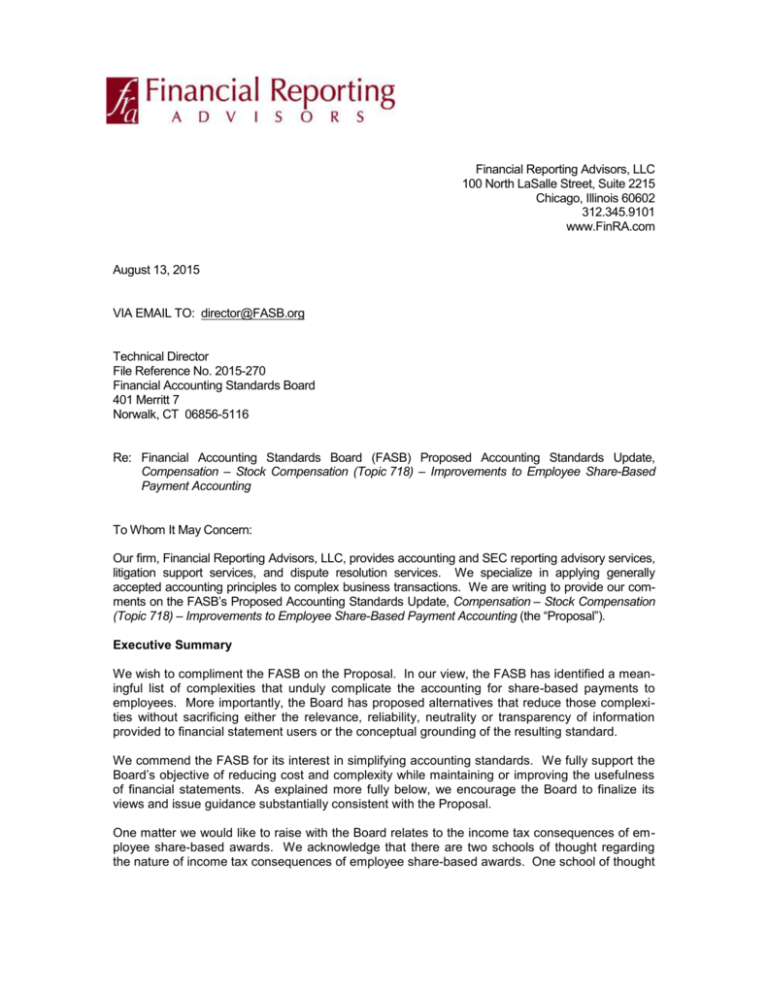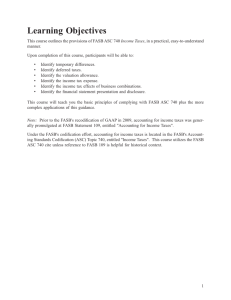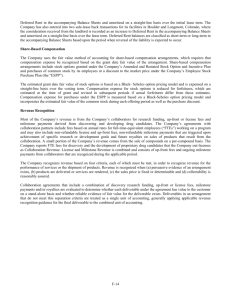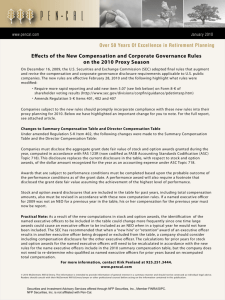Share-Based Payments - Simplification (2015)
advertisement

Financial Reporting Advisors, LLC 100 North LaSalle Street, Suite 2215 Chicago, Illinois 60602 312.345.9101 www.FinRA.com August 13, 2015 VIA EMAIL TO: director@FASB.org Technical Director File Reference No. 2015-270 Financial Accounting Standards Board 401 Merritt 7 Norwalk, CT 06856-5116 Re: Financial Accounting Standards Board (FASB) Proposed Accounting Standards Update, Compensation – Stock Compensation (Topic 718) – Improvements to Employee Share-Based Payment Accounting To Whom It May Concern: Our firm, Financial Reporting Advisors, LLC, provides accounting and SEC reporting advisory services, litigation support services, and dispute resolution services. We specialize in applying generally accepted accounting principles to complex business transactions. We are writing to provide our comments on the FASB’s Proposed Accounting Standards Update, Compensation – Stock Compensation (Topic 718) – Improvements to Employee Share-Based Payment Accounting (the “Proposal”). Executive Summary We wish to compliment the FASB on the Proposal. In our view, the FASB has identified a meaningful list of complexities that unduly complicate the accounting for share-based payments to employees. More importantly, the Board has proposed alternatives that reduce those complexities without sacrificing either the relevance, reliability, neutrality or transparency of information provided to financial statement users or the conceptual grounding of the resulting standard. We commend the FASB for its interest in simplifying accounting standards. We fully support the Board’s objective of reducing cost and complexity while maintaining or improving the usefulness of financial statements. As explained more fully below, we encourage the Board to finalize its views and issue guidance substantially consistent with the Proposal. One matter we would like to raise with the Board relates to the income tax consequences of employee share-based awards. We acknowledge that there are two schools of thought regarding the nature of income tax consequences of employee share-based awards. One school of thought File Reference No. 2015-270 August 13, 2015 Page 2 (“View A”) is that the tax deduction the company ultimately receives for employee share-based awards contains two components. One component, which represents the tax effect of compensation measured at grant date, belongs in income. The other component, which represents the effect of changes in the company's stock price subsequent to the grant date and is not measured until the award vests or is settled, should be recorded directly to equity. The alternative school of thought (“View B”) is that the total tax deduction relates to employee compensation and should be reported in the income statement. The Proposal is consistent with View B. Although some members of our firm prefer View A and others prefer View B, we are unanimous in our view that either of these two methods is preferable to current GAAP. We consider the current accounting model, which takes all excess tax benefits and some tax deficiencies to equity, unnecessarily complex and difficult to understand. We also find little conceptual basis for taking some tax deficiencies to equity and others to the income statement. Accordingly, we are willing to put our individual preferences aside in the interest of improving GAAP. Whether the Board moves forward with View B, consistent with the Proposal, or is persuaded by proponents of View A, we encourage the Board to finalize and issue the update. Specific Comments Our responses to the specific questions posed by the Board follow. In the Appendix to this letter we present a handful of detailed questions and suggestions on certain paragraphs of the Proposal. Question 1 – Simplification Objective: We believe the proposed amendments will simplify the accounting for share-based payments in a meaningful way without sacrificing the relevance, reliability, neutrality or transparency of information provided to financial statement users. We also believe the Board has achieved the simplification objective in a manner that is conceptually grounded. Although the amendment related to forfeitures will permit companies to choose between acceptable alternative accounting policies, we see no reason to believe that the differences resulting from those two alternatives will significantly diminish comparability. Question 2 – Excess Tax Benefits and Deficiencies: We do not believe it is necessary to delay recognition of an excess tax benefit until realization. In our view, that exception to the general requirement for recognition of tax benefits is an unnecessary complication that does not improve the usefulness of financial statements. As noted above, we have mixed views regarding whether excess tax benefits and deficiencies should be recognized in the income statement, as proposed by the Board. Some members of our firm would prefer to record excess benefits and deficiencies directly to equity (View A). They believe these excess amounts represent the tax effects of equity instruments. If changes in an entity’s stock price should not affect income, then the income tax consequences of those changes should also be excluded from income. In their view, the fact that the equity instrument was awarded to an employee is not relevant to the accounting for these tax consequences. Given that grant date is the date an employee begins to benefit from, or be adversely affected by, subsequent changes in the price of the employer’s equity shares, an employee holding the reporting entity’s equity instruments is in substantially the same economic File Reference No. 2015-270 August 13, 2015 Page 3 position as non-employee holders of the reporting entity’s equity instruments. Proponents of this view also observe that the excess tax benefits and deficiencies would create volatility in the reporting entity’s income tax expense that is unrelated to operations and is thus likely to be excluded by users in their analysis of reported results. Further, they note that recording excess tax benefits and deficiencies in income, as proposed by the FASB, adds to the complexity of estimating annual effective tax rates for interim reporting. Other members of our firm would prefer to record all tax consequences of employee compensation in the income statement (View B). They consider the “excess” benefits and deficiencies to be the same as any other book-tax difference generated by the reporting entity’s normal business activities. In their view, the total income tax consequence of employee compensation expense, regardless of when or how it is computed, should be reported in the income statement. While proponents of this view acknowledge that post-grant-date changes in the stock price of the reporting entity affect the amount of tax benefit associated with the compensation arrangement, they do not consider this as being economically equivalent to recording changes in the company’s stock price in income. To the contrary: the use of vesting or settlement date value to compute the amount of the tax deduction simply underscores that the reporting entity’s effective tax rate on compensation expense varies from the statutory tax rate. Proponents of this view are not persuaded that volatility should be a basis for excluding an item from income. Further, they believe that, while some users may exclude the “excess” tax effects from their analysis of reported results, users are more likely to overlook the substantive, often significant consequences of those tax effects if the amounts are recorded directly to equity. As to the added complexity of estimating annual effective tax rates for interim reporting, a straightforward solution to that problem would be for the FASB to permit companies to treat the “excess” tax effects as a discrete item in each interim period. Despite our differing positions on the appropriate underlying concept for excess tax benefits, we are unanimous in our view that the current accounting model is inconsistent with the financial reporting objective of neutrality. Treating “net debits” different from “net credits” introduces inappropriate bias into the results of operations. Current accounting is also needlessly complex and hard to understand. Accordingly, our recommendation to the FASB is to pick one of the two models (View A: all excess benefits and deficiencies to equity or View B: all excess benefits and deficiencies to income), explain your rationale, and move on. Question 3 – Cash Flow Presentation of Excess Tax Benefits: Given the Board’s proposal to present excess tax benefits in income, we agree that the corresponding cash flows should be classified as operating. However, if the Board were to conclude that all excess benefits and deficiencies should be recorded directly to equity (as discussed in Question 2), then we believe it would be appropriate to report the related cash flows as a financing activity. Question 4 – Accounting for Forfeitures: We support providing reporting entities with the option to account for forfeitures as they occur. We agree that the current requirement to estimate forfeitures has strong conceptual merit but we find little reason to object to a more pragmatic approach of recording forfeitures as they occur, similar to the approach that was permitted in FASB Statement No. 123, Accounting for Stock-Based Compensation. We see no basis to restrict the use of the pragmatic alternative to non-public entities. Question 5 – Withholdings for Employee Taxes: We support the Board’s proposal to slightly broaden the exception to liability classification for awards that permit partial cash settlement for File Reference No. 2015-270 August 13, 2015 Page 4 an employer’s statutory tax withholding requirements. As the FASB noted when it deliberated this question in 2004 in connection with FASB Statement No. 123R, Share-Based Payment, (SFAS No. 123R): B126. Certain respondents to the Exposure Draft asked that the exception for minimum statutory withholding requirements be extended to encompass amounts in excess of the minimum statutory withholding requirements. As noted in paragraph B125, the Board included the exception for minimum statutory requirements for pragmatic rather than conceptual reasons. The Board therefore declined to extend the exception beyond the minimum statutory requirements to which the related exception in Opinion 25 and Interpretation 44 applied. We acknowledge the longstanding acceptance of this departure from the underlying conceptual difference between an equity-classified award and a liability-classified award. We consider it an appropriate, pragmatic exception that reflects the realities of income tax regulations. Restricting the withholding to the statutory minimum was a way to clearly define the limit of the exception and prevent abuse. But the same objectives can be achieved by restricting the amount withheld to the statutory maximum. Accordingly, we support the Board’s proposed change. Question 6 – Cash Flow Statement Classification of Cash Paid by an Employer for Employee Tax Withholdings: We support classifying cash outflows for employee tax withholdings as financing cash flows. We agree with the Board’s rationale: the transaction between the employer and employee is economically equivalent to a share repurchase and thus is not an operating activity. Question 7 – Classification of Awards with Repurchase Features: We agree that any Board conclusion on this topic should apply equally to public and non-public entities. However, we strongly recommend that the Board defer changing the accounting model for awards with repurchase features that are within the employee’s control. Alternatively, we suggest that the Board limit any change to existing literature to narrow issues, such as call rights that can only be exercised by the 1 employer contingent on an event that is within the control of the employee. We strongly encourage the Board to defer a broader change to awards with an employee put right pending the Board’s finalization of its debt vs. equity project. At the time SFAS No. 123R was issued, the authoritative literature provided no guidance on the debt vs. equity classification of outstanding shares embodying a conditional obligation to transfer assets (for example, shares that give the employee the right to require the employer to repurchase them for cash equal to their fair value [puttable shares] awarded under share-based payment arrangements). Because repurchase features are not unusual in share-based payment arrangements and because the Board was actively considering the distinction between liabilities and equity as part of its liability and equity project, the FASB decided to provide interim guidance 2 based largely on practice at the time in order to “disrupt practice as little as possible.” The authoritative literature continues to provide no guidance on this topic. Accordingly, we continue to believe that the FASB should “disrupt practice as little as possible” by making no change to practice until such time as the FASB resolves the broader issue of classification of shares containing a conditional obligation to transfer assets. Our preference is to change share-based literature just once and to make a change based on a clear concept that applies broadly to such 1 See paragraph BC22 of the Proposal 2 See paragraphs BC133-135 of SFAS No. 123R. File Reference No. 2015-270 August 13, 2015 Page 5 arrangements, not just narrowly to employee-specific transactions. To the extent that there is some diversity in practice around call rights that can only be exercised by the employer contingent on an employee-controlled event, the Board can resolve that diversity. (We support treating that specific fact pattern equivalent to an employee put if the employer is likely to call the shares when the employee’s action triggers the employer’s call right.) We believe that complexity and cost are unaffected by the existing distinction that share-based compensation accounting literature makes between employee puts and employer calls. In fact, the blanket requirement to treat share-based awards with repurchase features embodying an employee put as a liability makes life simple. Yes, there are nuanced fact patterns that require judgment because of their complexity, but the Proposal adds judgment and, in that way, complexity to every fact pattern, including “plain vanilla” ones. Thus we see this change as unnecessarily and perhaps prematurely adding to complexity. If the conceptually grounded answer is to treat puts and calls similarly, then change is warranted. But until the concept is determined, we think that it is simpler and less costly to “leave well enough alone.’’ Question 8 – Estimating Expected Term: We support the Board permitting the use of a practical expedient for estimating the expected term of awards with performance conditions that affect vesting or service conditions. We agree that the practical expedient should represent an accounting policy and require, similar to the practical expedient for forfeitures, consistent application on an entity-wide basis. We further agree that the practical expedient should apply only to sharebased awards that have the characteristics identified in proposed paragraph 718-10-30-20B and should be estimated, under the practical expedient, in the manner described in proposed paragraph 718-10-30-20A. We would encourage the Board to permit both public and non-public entities to estimate expected term using a practical expedient. Given that the SEC staff has permitted a similar simplified approach for certain public companies for nearly a decade, it seems possible to us that users of public company financial statements might find the amount of imprecision resulting from the practical expedient acceptable. Question 9 – Intrinsic Value for Liability Classified Awards: Given that SFAS 123R permitted the use of intrinsic value to measure liability-classified awards granted by nonpublic entities at the time the standard was first issued, we see no reason to object to the Board permitting these entities a second opportunity to switch from fair value to intrinsic value. Questions 10 and 11 – Transition and Lead Time for Implementation: We are not in a position to provide meaningful input to these questions. ******** We appreciate the opportunity to respond to the Proposal. If you have any questions or would like to discuss our comments further, please contact Amy Ripepi at 312-345-9103. Sincerely, Appendix Detailed Comments Page 1 We have not performed an in-depth review of the many changes that will be necessary to revise the existing authoritative literature. However, as we read the Proposal, we noted a handful of paragraphs that we believe may merit revision or clarification. 1. Excess Tax Benefits ASC 718-10-50-2: The proposed amendment to this paragraph indicates that reporting entities should disclose “the amount of cash received from the exercise of share options … and the tax benefit from stock options exercised during the period.” Does “the tax benefit” refer to the aggregate amount of benefit recognized in the financial statements as either a reduction of currently payable tax or a deferred tax asset? Or is it the amount of benefit that the company is entitled to claim on its tax return, irrespective of whether the benefit has been recognized (e.g., because the company is in a tax loss carryforward position, does not currently pay income taxes and reduces its deferred tax assets by a valuation allowance)? Also note that, having deleted the word “realized” from the guidance, it would be possible for an accountant who is unfamiliar with historical development of this specific paragraph to interpret the amended guidance as permitting disclosure of either (i) the tax benefit recognized, (ii) the tax benefit that the entity is entitled to receive or (iii) the tax benefit realized via reductions in the amount of income taxes otherwise payable. 2. Forfeitures ASC 718-20-55-121: We suggest the Board more clearly state the accounting result in Example 15 under both accounting policies. In the specific example, if Entity Z’s accounting policy is to estimate forfeitures, the accounting result is (i) a reversal of the compensation expense recorded through December 12, 20X7 in the accounting period that includes that date, (ii) no compensation expense from that date to immediately prior to the modification date (June 30, 20X8) and (iii) $500,000 of expense in the period that includes the modification date (June 30, 20X8). If Entity Z’s accounting policy is to record forfeitures when they occur, the reversal of the compensation expense for forfeited awards will be reported in the same period as the modification (i.e., the period that includes June 30, 20X8) because the modification occurs at the date that the awards are forfeited. Further, compensation expense will be reported from the date employees are notified of their pending termination through the modification date (December 13, 20X7 through June 30, 20X8) without considering the likelihood of forfeiture. We also suggest that the example address the more likely scenario in which the modification to accelerate vesting occurs on December 12, 20X7, contemporaneous with the notification to employees of their pending termination. In our experience, employers generally do not wait until the termination date to accelerate vesting of awards that otherwise would be forfeited. More commonly, the modification will occur at the same time employees are notified so as to encourage employees to remain through the termination date. One reason we suggest illustrating the accounting for this alternative scenario is that the accounting result is not entire clear to us. Assume the modification to accelerate vesting occurs on December 12, 20X7 and termination occurs on June 30, 20X8. If forfeitures cannot be anticipated, would Entity Z continue to record compensation based on the original terms of the award (i.e., ignoring the likelihood of forfeiture) during this period and then recognize the effect of the modification and forfeitures on June 30, 20X8, i.e., at the date the awards are forfeited? ASC 718-10-50-2e: The amended language in this paragraph is awkward, making it difficult to read and understand. We strongly encourage the Board to state the disclosure requirement in a more straightforward, comprehensible manner. Appendix Detailed Comments Page 2 ASC 805-30-55-11: We believe the clarity of the proposed amendment to this paragraph would be significantly improved by making the final sentence (“An accounting policy election …”) the second sentence of the paragraph. This would make it clear that the requirement to “reflect the acquirer’s estimate of the number of replacement awards for which the requisite service is expected to be rendered” is unaffected by “an accounting policy election to account for forfeitures when they occur.” 3. Employee Tax Withholding ASC 718-10-25-18: In the proposed amendment to this paragraph, it is not clear to us whether the “maximum individual statutory rate” that establishes the threshold for determining liability classification is (a) the maximum statutory tax rate that applies to employees in the applicable tax jurisdiction or (b) the maximum statutory tax rate that applies to a specific individual employee in the applicable tax jurisdiction. The proposed amended paragraph refers twice to “the employee’s maximum individual statutory tax rate” (emphasis added) as if to suggest that the maximum rate is determined on an employee-by-employee basis. It was our understanding, based on BC16, that the Board’s intent was to permit the employer to determine the maximum statutory tax rate that applies to individuals in the applicable tax jurisdiction and use that one rate for all employees in that tax jurisdiction. If our understanding is correct, we strongly encourage the Board to revise its proposed wording to clearly indicate that the maximum rate would be the same for all employees within a specific tax jurisdiction. 4. Repurchase Features ASC 718-10-25-9: We note that the proposed amendment to this paragraph continues to use an initial public offering (IPO) as an example of a contingent event that would not meet the condition for classification as a liability award until it becomes probable that the IPO will occur. We note that the large accounting firms have longstanding, published interpretive guidance stating that in no circumstance can a liquidity event such as an IPO or a change in control meet the definition of probable. Accordingly, liability classification could never precede the date the IPO goes effective or the date the change in control occurs. Under the assumption that the FASB and its staff agree with this interpretive guidance, we strongly encourage the Board to use a different example of a contingent event in this paragraph. 5. Practical Expedient for Expected Term ASC 718-10-55-50A: We would encourage the Board to find a way to work the “implementation guidance” related to liability-classified awards in this paragraph into the narrative that appears in ASC 718-10-30-20. In our experience, the more disaggregated the guidance is on a specific accounting topic, the more difficult and time-consuming it is to research the topic. We also note that the entirety of ASC 718-10-55-34A and the first sentence of ASC 718-10-550-50A are redundant with ASC 718-10-30-20 and thus do not represent implementation guidance. 6. Intrinsic Value Paragraph 52 of the Proposal: We suggest that the last sentence of this paragraph be reworded as follows: “Without this provision, an entity would be unable to make this change because the literature states that fair value is preferable to intrinsic value.” We believe the phrase “an entity would need to demonstrate that intrinsic value is preferable to fair value” implies that an entity could adopt the intrinsic value method under existing GAAP. That seems unlikely on the basis that a change in Appendix Detailed Comments Page 3 3 accounting principle is permitted only if the change is to a preferable method and the literature currently states that “[t]he fair-value-based method is preferable for purposes of justifying a change in 4 accounting principle.” 3 See ASC 250-10-45-2 4 See ASC 718-30-35-4








